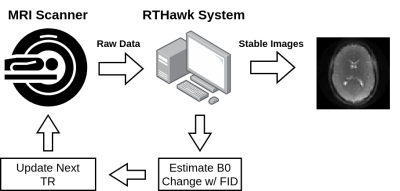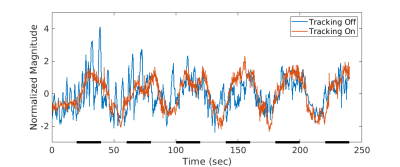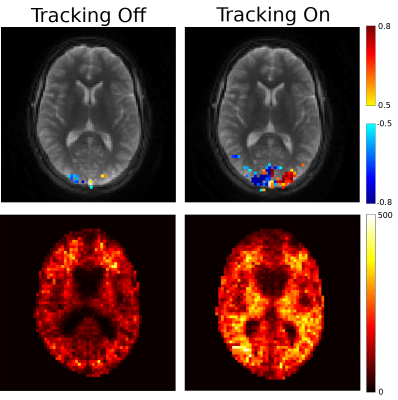1223
Real-Time Respiration Compensation in Oscillating Steady State fMRI1University of Michigan, Ann Arbor, MI, United States, 2Biomedical Engineering, University of Michigan, Ann Arbor, MI, United States
Synopsis
Oscillating Steady-State Imaging (OSSI) is a new steady-state sequence for high-SNR fMRI. Respiration-induced B0 changes cause undesirable changes to the OSSI steady-state, resulting in signal artifacts. To address this problem, we present a prospective correction method which utilizes a self-navigating spiral trajectory to measure and correct for B0 changes in real-time. In an initial fMRI proof-of-concept, our real-time correction method increased the number of activated voxels by 454% and increased mean tSNR by 81%. Real-time prospective correction has the potential to outperform retrospective correction methods by directly reducing perturbations to steady-state magnetization during acquisition.
Introduction
Oscillating Steady-State Imaging (OSSI) is a sequence that combines balanced gradients with a quadratic RF phase progression to produce a T2* sensitive steady-state. Using a quadratic phase progression creates a large periodically oscillating signal, creating the potential for highly SNR efficient acquisitions. Since the oscillations are periodic, each period of images can be combined to form temporally stable images suitable for fMRI. The BOLD sensitivity of OSSI is similar to transition band bSSFP fMRI methods, where oxygenation-dependent susceptibility changes directly create signal contrast.1,2 While OSSI's frequency sensitivity results in a desirable T2* weighting, it also increases sensitivity to respiration induced B0 changes. These respiration induced field changes have been well studied,3,4 and have successfully been prospectively corrected through various real-time approaches.4,5 Real-time prospective correction is potentially better than retrospective correction methods through the advantage of directly reducing perturbations to steady-state magnetization during acquisition. However, a real-time strategy correction strategy has not yet been used to maintain the stability of a complex steady-state magnetization such as OSSI. Here, we demonstrate the use of a self-navigating spiral method to track bulk B0 changes and correct for them in real-time, reducing respiration artifacts and improving functional signal sensitivity.Methods
An oscillating steady-state sequence with prospective correction was implemented using the RTHawk research platform (HeartVista, Los Altos CA, USA) to perform real-time data processing and scan parameter control of a GE MR750 3T system (GE Healthcare, Waukesha WI, USA). The RF phase was linearly incremented between excitations by $$$\phi(n) - \phi(n-1)=\frac{2\pi}{n_c}n$$$, creating a steady-state magnetization that oscillates over a period of $$$n_c$$$ TRs. Using this excitation strategy, a 2D single slice time series was acquired with a balanced spiral readout with two interleaves (TR=16ms, FA=10$$$^\circ$$$, $$$n_c$$$=10). The root mean square of every 10 images was used to form one "combined" image with an effective TR of 320 ms. B0 changes were estimated in real-time by measuring the phase accumulation before and after the balanced spiral readout, using 16 extra samples of the center of k-space. Phase-measurements were calculated individually for all 32 receive coils, then coil-compressed using an SVD-based approach to produce a bulk B0 measurement every 10 TRs (160 ms). The effects of eddy currents were measured per-shot in a calibration step and included in the B0 measurement. The quadratic RF phase progression was then adjusted to compensate for the measured B0 change, minimizing perturbations to the steady-state. Effectiveness of the real-time system was assessed using a task-based fMRI experiment, consisting of a counter-phased flashing checkerboard (20 seconds per block, 4 minutes total). Linear and quadratic detrending were included in the functional analysis. No other spatial smoothing or post-processing steps were applied.Results
Figure 1 shows the first 30 temporal frames of the OSSI sequence in a phantom and brain, as well as the resulting RMS combined image. Different banding artifacts can be seen in each frame due to B0 inhomogeneity. Figure 2 shows a process diagram depicting the real-time control system using RTHawk, which is able to process data in real-time and update scan parameters on a per-TR basis. Respiration artifacts were successfully reduced as shown in Figure 3, depicting voxel timecourses with and without tracking. Figure 4 shows the improvement in activation maps and tSNR maps.Discussion
Real-time prospective correction is able to mitigate respiration artifacts in OSSI fMRI by compensating for respiration-induced B0 changes. The self-navigation method for B0 measurement only relies on using a balanced readout trajectory, where the center of k-space can be sampled before and after the readout. Relative changes in off-resonance will then cause a proportional change of this phase measurement. Compensation through RF phase adjustment can only account for uniform B0 changes across the slice, while respiration-induced B0 changes are known to spatially vary throughout the brain. This results in imperfect B0 compensation across the slice, however initial results shown in Figure 4 indicate that even partial compensation can result in large improvements in functional sensitivity and tSNR.Conclusion
OSS fMRI combines the desirable SNR efficiency of bSSFP with T2* weighting suitable for fMRI. This proof of concept shows that a self-navigating spiral readout can be used to estimate bulk B0 changes in real-time. The system also for per-shot eddy current effects, updating the RF transmit and receive phases to mitigate perturbations to the oscillating steady-state. Ultimately, this results in an increase of activated voxels, increased activation strength, and increased overall tSNR.Acknowledgements
This work was supported by the National Institute of Biomedical Imaging and Bioengineering (NIBIB) and the National Institute of Neurological Disorders and Stroke (NINDS) through grants R01EB023618 and U01 EB026977.References
[1] Klaus Scheffler, Erich Seifritz, Deniz Bilecen, Ramesh Venkatesan, Jurgen Hennig, Michael Deimling, and E. Mark Haacke. Detection of BOLD changes by means of a frequency-sensitive trueFISP technique: Preliminary results. NMR in Biomedicine, 14(7-8):490–496, 2001. ISSN 09523480. doi:10.1002/nbm.726.2
[2] Karla L. Miller, Brian A. Hargreaves, Jongho Lee, David Ress, R. Christopher DeCharms, and John M. Pauly. Functional brain imaging using a blood oxygenation sensitive steady state. Magnetic Resonance in Medicine, 50(4):675–683, 10 2003. ISSN 07403194. doi: 10.1002/mrm.10602.
[3] D. C. Noll and W. Schneider. Theory, simulation, and compensation of physiological motion artifacts in functional MRI. International Conference on Image Processing, ICIP, volume 3, pages 40–44. IEEE Computer Society, 1994. doi: 10.1109/ICIP.1994.413892.
[4] Kevin Murphy, Rasmus M. Birn, and Peter A. Bandettini. Resting-state fMRI confounds and cleanup. NeuroImage, 80:349–359, 10 2013. ISSN 10538119. doi: 10.1016/j.neuroimage.2013.04.001.
[5] P. Van Gelderen, J.A. de Zwart, P. Starewicz, R.S. Hinks, and J.H. Duyn. Real-time shimming to compensate for respiration-induced B0 fluctuations. Magnetic Resonance in Medicine, 57(2):362–368,2 2007. ISSN 07403194. doi: 10.1002/mrm.21136. URLhttp://doi.wiley.com/10.1002/mrm.21136.
[6] Jongho Lee, Juan M. Santos, Steven M. Conolly, Karla L. Miller, Brian A. Hargreaves, and John M. Pauly. Respiration-induced B0 field fluctuation compensation in balanced SSFP: Real-time approach for transition-band SSFP fMRI. Magnetic Resonance in Medicine, 55(5):1197–1201, 5 2006. ISSN 0740-3194. doi: 10.1002/mrm.20879. URLhttp://doi.wiley.com/10.1002/mrm.20879.
Figures



